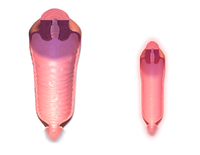
Photo from wikipedia
Introduction. Premature rupture of the membrane (PROM) can trigger significant maternal complications, even maternal and fetal morbidity or mortality.Hypothesis. Inflammatory status and vaginal flora might be utilized to predict the… Click to show full abstract
Introduction. Premature rupture of the membrane (PROM) can trigger significant maternal complications, even maternal and fetal morbidity or mortality.Hypothesis. Inflammatory status and vaginal flora might be utilized to predict the occurrence of PROM.Aim. To explore the association between the occurrence of PROM and vaginal flora and inflammatory status alteration.Methodology. A case-control cross-sectional study was carried out on 140 pregnant women with or without PROM. Socio-demographic characteristics, vaginal flora assessment, pregnant outcomes and Apgar score information were retrieved.Results. Pregnant women with PROM showed an increased incidence of vulvovaginal candidiasis (VVC), trichomonas vaginitis (TV) and bacterial vaginitis (BV) with dysregulated vaginal flora and diminished fetal tolerance of labour indicated by down-regulated Apgar score. The increased rate of prematurity, puerperal infection and neonatal infection could be detected in PROM patients with imbalanced vaginal flora compared with PROM patients with normal vaginal flora. ROC analysis suggested IL-6 and TNF-α yielded the best discrimination for the prediction of PROM.Conclusion. Altered vaginal and inflammatory status are associated with PROM, and IL-6 and TNF-α can predict the occurrence of PROM.
Journal Title: Journal of medical microbiology
Year Published: 2023
Link to full text (if available)
Share on Social Media: Sign Up to like & get
recommendations!